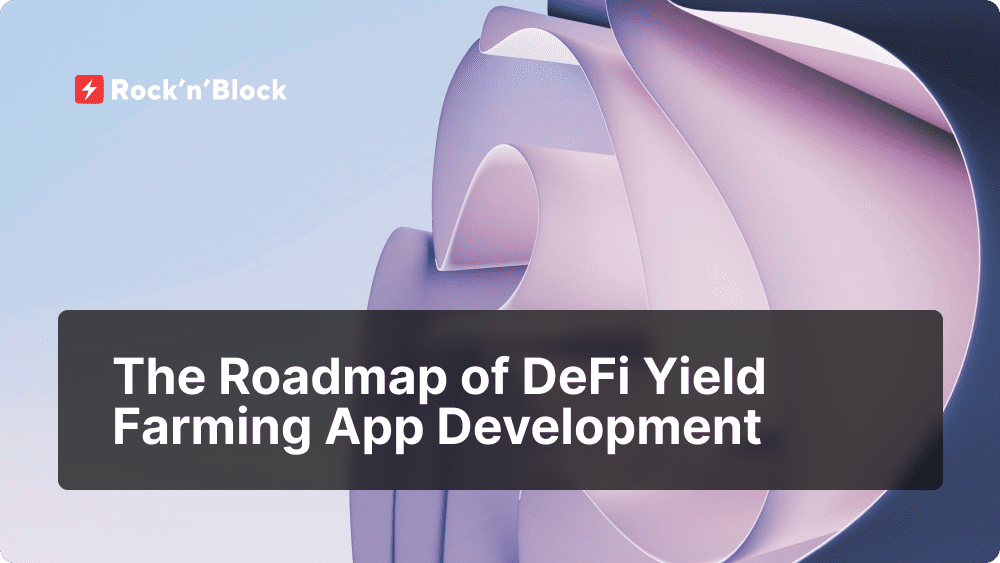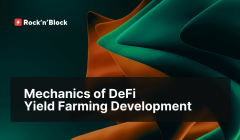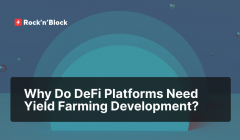The Roadmap of DeFi Yield Farming App Development
03 May 2024Yield farming has emerged as a groundbreaking mechanism for users to earn passive income by providing liquidity to various protocols and platforms. As DeFi continues to revolutionize traditional financial systems, yield farming apps present a thriving opportunity for DeFi platforms and investors alike. In this article, we explore the essential steps involved in DeFi yield farming app development, offering insights and practical guidance to empower individuals and businesses to harness the full potential of this transformative tool.

Table of Contents:
-
Understanding the Yield Farming Landscape
-
How to Create a DeFi Yield Farming App
-
Step 1: Preparation and Planning for DeFi Yield Farming App Development
-
Step 2: Tokenomics Design
-
Step 3: Choosing the Right Blockchain for DeFi Yield Farming App Development
-
Step 4: DeFi Yield Farming App Development
-
Step 5: Testnet Deployment and Simulation
-
Step 6: Mainnet Deployment
-
The Role of a DeFi Yield Farming Development Company
Understanding the Yield Farming Landscape
Overview of DeFi and Yield Farming
DeFi, short for decentralized finance, refers to a broad category of financial services built on blockchain technology, aiming to decentralize traditional financial systems. Yield farming, also known as liquidity mining, is a practice within DeFi where investors provide liquidity to decentralized protocols in exchange for rewards, typically in the form of tokens.
By incentivizing liquidity provision through farming opportunities, DeFi apps can deepen their liquidity pools and attract more users. Yield farming mechanisms can also align the interests of token holders with the overall success of the protocol, enhancing app governance.
Key Components
To successfully navigate DeFi yield farming, it's important to understand the key components and terminology involved. This includes concepts such as smart contracts, decentralized exchanges (DEXs), liquidity pools and LP tokens.
Smart contracts are self-executing programs that underpin the entire technical infrastructure of decentralized finance. Smart contracts development in yield farming automates intricate processes within yield farming, executing actions like staking, and reward distribution with precision and transparency.
Decentralized exchanges development enables users to trade cryptocurrencies directly with one another without the need for intermediaries, providing liquidity through automated liquidity pools.
Liquidity pools consist of funds locked in smart contracts, providing liquidity for trading pairs on decentralized exchanges. Participants contribute assets to these pools and earn rewards based on trading fees and other incentives.
Liquidity Provider (LP) tokens represent ownership rights in a specific liquidity pool and are generated when users deposit pairs of tokens into the pool.
Read more about key yield farming components in our thorough guide: Explaining Mechanics of DeFi Yield Farming Development!
Market Trends and Emerging Technologies
The DeFi landscape is dynamic, with new trends and technologies constantly emerging. It is crucial for DeFi developers, project owners, and investors to stay up-to-date with market trends and innovations.
Some notable trends include the rise of decentralized derivatives platforms and the integration of non-fungible tokens (NFTs) into DeFi ecosystems.
Emerging technologies such as Layer 2 scaling solutions, cross-chain interoperability protocols, and decentralized autonomous organizations (DAOs) are reshaping the DeFi landscape, offering solutions to scalability, interoperability, and governance challenges.
By staying informed about market trends and embracing emerging technologies, opportunities can be seized and contribute to the continued evolution of DeFi yield farming app development.
How to Create a DeFi Yield Farming App
Yield farming app development offers many benefits for DeFi platforms looking to capitalize on the growing DeFi landscape. Building a successful DeFi yield farming app requires careful planning, technical expertise, and a deep understanding of the complexities involved. In the sections below, we'll explore the steps involved in creating a DeFi yield farming app, empowering project owners and developers to navigate the intricate process with confidence and clarity.
Step 1: Preparation and Planning for DeFi Yield Farming App Development
Preparing for DeFi yield farming app development requires careful planning and research. Let's delve into the key steps involved in preparation and planning for yield farming app development.
Research and Market Analysis
Before diving into the DeFi yield farming project development, it's essential to conduct comprehensive research and market analysis. This involves gaining a deep understanding of the current DeFi landscape, including trends, protocols, and emerging technologies. By analyzing existing yield farming platforms, developers can identify gaps in the market and opportunities for innovation.
Research should include an analysis of user behaviors, preferences, and pain points within the DeFi ecosystem. Understanding the needs of potential users enables developers to tailor their yield farming project to address specific market demands effectively.
Defining Project Objectives and Goals
With the insights gained from research and market analysis, you can proceed to define clear project goals and objectives for the DeFi yield farming app development. These objectives should align with the project's mission and address the needs of target users.
Objectives may include enhancing liquidity provision and optimizing yield generation mechanisms. By articulating specific goals, yield farming developers can focus their efforts and resources on achieving tangible outcomes.
Establishing key performance indicators (KPIs) allows project teams to track progress and measure the success of a DeFi yield farming app against predefined benchmarks.
Step 2: Tokenomics Design
Tokenomics design is a crucial aspect of DeFi yield farming app development, shaping the economic incentives and governance mechanisms that drive participation and value creation within the platform.
Central to the tokemomics design for yield farming is the rewards structure, which defines how tokens are allocated to participants based on their contributions or actions within an app. The rewards structure plays a pivotal role in incentivizing desired behaviors, such as liquidity provision, while balancing economic considerations and community interests.
Rewards structure defines:
-
Reward Calculation
-
APY (Annual Percentage Yield)
-
Entry Policy/Exit Policy
-
Multipliers
-
Integration with Oracle Services
-
Time-Weighted Rewards
By carefully designing the rewards structure, tokenomics aims to foster engagement, drive value creation, and promote sustainable growth within the ecosystem, aligning the interests of participants with the overarching goals of an app.
Tokenomics design also entails determining the source of funds for rewards, which can significantly impact the sustainability and viability of the ecosystem. These funds may be generated through various mechanisms such as transaction fees, protocol-generated revenue, or token issuance events like initial coin offerings (ICOs) or token sales.
Step 3: Choosing the Right Blockchain for DeFi Yield Farming App Development
Considerations for Blockchain Selection
When evaluating blockchain options for DeFi yield farming app development, developers should consider several factors:
- Scalability: Assess the scalability of the blockchain to accommodate the potential growth of the yield farming platform and handle increasing transaction volumes efficiently.
- Security: Prioritize blockchain platforms with robust security features, including consensus mechanisms, smart contract auditing, and bug bounty programs, to mitigate the risk of vulnerabilities and attacks.
- Interoperability: Consider blockchain platforms that support interoperability with other protocols and networks, facilitating seamless integration with external DeFi ecosystems and enhancing liquidity provision.
- Community Support: Evaluate the size and activity of the developer community surrounding the blockchain platform, as community support contributes to innovation, adoption, and ecosystem growth.
- Ecosystem Development: Assess the maturity and diversity of the DeFi ecosystem built on the blockchain, including the availability of decentralized exchanges, lending protocols, and liquidity pools.
Explore How to choose a blockchain platform for your business!
Popular Blockchain Platforms for DeFi Projects Development
Several blockchain platforms have gained prominence in the DeFi space, offering features and functionalities conducive to yield farming app development:
- Ethereum: Ethereum is widely adopted for many DeFi project types due to its robust ecosystem, developer-friendly tools, and broad community support.
- BNB Chain: It is a popular alternative to Ethereum, offering lower transaction fees and faster confirmation times.
- Polygon: Polygon is a layer 2 scaling solution for Ethereum, providing high throughput and low-cost transactions while maintaining compatibility with Ethereum's network.
Step 4: DeFi Yield Farming App Development
Smart Contract Development
Smart contracts play a central role in the DeFi yield farming app operations, facilitating automated execution of protocols and ensuring transparent and trustless interactions between participants. Additionally, DeFi yield farming smart contract development incorporates complex algorithms to determine yield distribution, considering factors such as staking duration and pool participation.
Develop the smart contracts based on the needed functionalities. Code the yield farming logic and any additional features specified.
Security and efficiency are paramount considerations. Writing secure code helps mitigate the risk of vulnerabilities and potential exploits, safeguarding user funds and preserving the integrity of the protocol.
Learn more about smart contracts in yield farming by reading our related article: A Guide to DeFi Yield Farming Smart Contract Development!
Frontend Development
In DeFi yield farming app development, frontend development and UX (User Experience) design are integral components for creating successful and user-friendly platforms. Frontend development focuses on building the visual elements and interactive features of the app, while UX design ensures that users have a seamless and intuitive experience when interacting with the platform.
When designing the UX/UI for a yield farming app, developers should consider the main principles:
- Intuitive Navigation: Design clear and intuitive navigation pathways that guide users through the app's functionalities and features.
- Simplified Onboarding: Streamline the onboarding process for new users by minimizing friction and complexity. Provide user-friendly tutorials, tooltips, and educational resources.
- Responsive Design: Optimize an app for responsiveness across different devices and screen sizes, ensuring a seamless and consistent user experience regardless of the user's device or browser.
- Accessibility: Prioritizing accessibility considerations is crucial to ensure that an app is usable by all users, including those with disabilities or impairments.
Frontend development involves implementing the user interface (UI) design and bringing it to life using web technologies such as HTML, CSS, and JavaScript. Developers create layouts, buttons, forms, and other interface elements that allow users to navigate the app and interact with its features.
Front-end development also includes the integration of wallet connection (for example, Metamask), that allows users to interact with the yield farming app directly from their crypto wallets. Incorporating smart contract calls allows users to facilitate various actions through the app’s interface. The integration of yield calculators and dashboards enable users to estimate their potential earnings and monitor yield farming activities.
Step 5: Testnet Deployment and Simulation
Testnet deployment and simulation enable developers to validate the functionality and performance of DeFi yield farming app in a controlled environment before deploying to the mainnet. The testnet deployment and simulation include:
- Risk Mitigation: Testnet deployment allows developers to identify and address issues without risking real funds or disrupting live operations on the mainnet. Test environments simulate real-world conditions while providing a safe sandbox for experimentation.
- Validation: Testnet deployment validates the integration of smart contracts, frontend interfaces, and external dependencies, ensuring seamless interaction and interoperability across different components of an app.
- Scalability Testing: Testnet environments facilitate scalability testing by simulating high transaction volumes and network congestion to evaluate an app's performance under stress conditions. Developers can analyze performance metrics, identify bottlenecks, and optimize resource allocation accordingly.
During this step of the DeFi yield farming app development process, prioritize bug fixing and optimization based on the insights and observations gathered during testnet deployment and simulation. Address critical issues, performance bottlenecks, and usability concerns iteratively to improve the overall quality and reliability of an app.
Step 6: Mainnet Deployment
Mainnet deployment marks a significant milestone in the journey of DeFi yield farming app development, transitioning from testing environments to live production environments.
Deploying a DeFi yield farming app on the mainnet requires careful planning and execution:
- Version Control: Maintain version control of smart contracts and frontend interfaces to track changes, revert updates if necessary, and maintain a stable release history.
- Contingency Plans: Establish contingency plans in case of unexpected issues or emergencies on the mainnet. Define procedures for pausing, upgrading, or rolling back an app in response to critical incidents or security threats.
To maintain stability and reliability of a DeFi yield farming app on the mainnet, continuous monitoring and proactive troubleshooting are essential. It is important to provide responsive support to users by addressing inquiries, resolving issues and disputes in a timely manner. Additionally, fostering a positive and supportive community culture can encourage user engagement and loyalty on the mainnet.
The Role of a DeFi Yield Farming Development Company
Navigating the intricacies of DeFi yield farming app development can be a challenging task, requiring expertise in blockchain technology, smart contract development, and decentralized finance principles. To ensure the best possible outcome, it is wise to seek guidance from a reputable company that provides expert DeFi yield farming development services. These companies possess the necessary technical prowess and industry knowledge to assist businesses and entrepreneurs at every stage of the development process. From conceptualization and planning to implementation and deployment, the role of DeFi yield farming development company is to provide invaluable insights, guidance, and support, streamlining the development journey and maximizing the potential for success. By leveraging the expertise and experience of a trusted development partner, businesses can navigate the complexities of DeFi yield farming with confidence, ultimately realizing their vision for a robust and thriving decentralized finance platform.
We ❤️ Development
Follow us on social media to receive the hottest blockchain development updates
Twitter ⚡️Telegram⚡️LinkedIn⚡️Facebook







